www.TestsTestsTests.com
Excel Ribbon & Quick Access Toolbar Tutorial
Excel 2016 Tutorial – Learn Excel Basics
Free Online Microsoft Excel Tutorials
* What is the Ribbon in Excel 2016?
* Show Ribbon in Excel – Hide Ribbon in Excel 2016
* How to find Excel Functions on the Ribbon in Excel 2016
* Contextual tabs that disappear
* Quick Access Toolbar Excel 2016 – The shortcut menu or QAT
* Adding buttons to the Quick Access Toolbar Excel 2016
|
The Ribbon and Quick Access toolbars in Excel are the control centers for functions, options and settings needed to create and edit worksheets. |
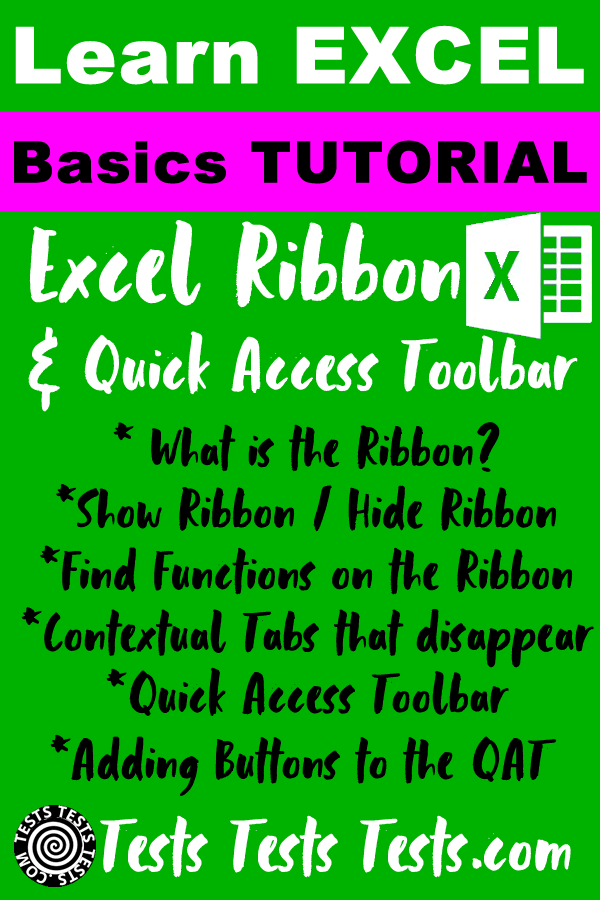 |
* What is the Ribbon in Excel 2016?
The Ribbon in Microsoft Office applications is the name given to the bar at the top of the Excel 2016 screen which contains functions, options and settings required to create and edit worksheets. The Ribbon is divided into different functional areas using tabs, and under each Ribbon tab, you will find function buttons organized into groups of related command buttons.
Study the screenshot of the Excel Ribbon / Menu area below. Can you identify these areas in your own version of Microsoft Excel 2016?

1. Tabs: Home, Insert, Page Layout, Formulas, Data, Review and View are all default menu tabs on the Ribbon. When clicked, each of these tabs open a different area of the Ribbon with option buttons pertaining to the name of the tab under which they are located.
2. Ribbon area (also known as Commands): This is where the option buttons relating to the selected tab on the Ribbon, is located. Option buttons are organized into named groups divided by a single vertical line.
3. Search the Ribbon: Click and type into this area to find an Excel function.
4. Ribbon display options: Select to show/hide the Ribbon, the Ribbon Tabs and Command area.
5. Hide the Ribbon: Click to collapse (hide) the Ribbon.
Go ahead and experiment in Excel:
- What happens when you click each of the tabs at the top of your Excel screen: Home, Insert, Page Layout, Formulas, Data, Review and View?
- Can you tell when a Tab is selected? Did the Ribbon area (Commands) change as you clicked on each tab?
Let’s investigate how the Ribbon commands area is organized. Study the screenshot below of two groups usually found under the Home tab. Can you find these on your version of Excel?
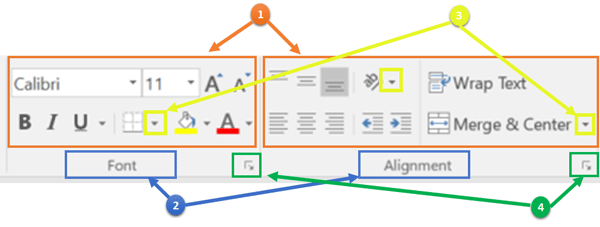
The areas identified above, which are numbered and color-coded, are:
1. Groups – these contain individual buttons (commands) that can be clicked to use the option. For most commands you will need to have selected content in your worksheet or have your cursor positioned within a cell in the worksheet.
2. Group names – each group on the Excel Ribbon has a name that pertains to the buttons in the group. In the screenshot above the Font and Alignment groups are outlined in blue.
3. More options – some buttons have further options when you click the small triangle to the right of/or below the button. The further options identified in the screenshot example above will give you different border, text orientation and merge and center options.
4. Dialog Box Launcher – many groups on the Ribbon have a small triangle in its bottom right-hand corner. Click on this icon to launch a dialog box that contains a plethora of options relating to the group.
The screenshot in our example contains only two groups found under the Home tab on the Ribbon. The Ribbon contains over 40 groups which can be accessed by clicking on one of the Ribbon tabs.
* Show Ribbon in Excel – Hide Ribbon in Excel 2016
The Ribbon in Excel can be displayed in full, partially or completely hidden. It is important to know where to find the options to manage the Ribbon display settings, not only to maximize the worksheet area on your computer screen, but also to re-display a Ribbon that has disappeared.
Study the screenshot below. Can you find these Ribbon display options in your version of Excel?
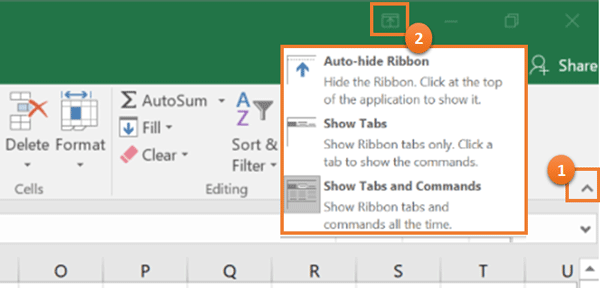
1. To hide the Ribbon: click on the Collapse the Ribbon icon to the right of the Ribbon area.
2. Click on the Ribbon Display Options button to:
- Auto-hide Ribbon – this will hide the entire Ribbon area.
- Show Tabs – this will show the tabs at the top of the Ribbon only
- Show Tabs and Commands – this is the default Ribbon view, which displays the whole Ribbon (Tabs, groups and buttons).
To re-display the Ribbon try one of these options:
1. Hold down the Control key on your keyboard and press the F1 key (Ctrl+F1). This will re-display the Ribbon regardless of which parts are hidden.
2. Right-click one of the Tabs on the Ribbon and select Collapse the Ribbon from the menu that appears.
3. Click on the Ribbon Display Options button and select one of the display options from the menu that appears.
* How to find Excel Functions on the Ribbon in Excel 2016
A common frustration experienced by Microsoft Office users in the past have been the difficulty in locating a function on the menu bar or Ribbon. Excel 2016 comes with a fantastic new feature, the aptly titled Tell me what you want to do search box which allows users to search for any function using descriptive words.
To use this search function on the Ribbon:
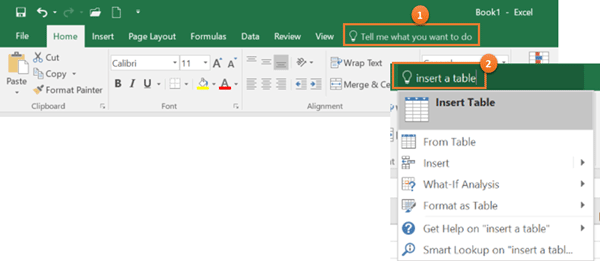
1. Click on the words Tell me what you want to dolocated to the right of the last tab on the Ribbon.
2. Type a search term, for example, insert a table.
Excel will make suggestions based on your search term, and if any of these match what you are looking for, simply click on the option to use the function.
* Contextual tabs that disappear
Contextual tabs are Ribbon tabs that only appear when specific content is selected. Not knowing how these tabs work can lead to frustration as tabs and functions that were visible one moment, may randomly appear to be missing the next.
To experiment with contextual tabs, try the following:
In an open Excel worksheet, click on the Insert tab. In the Illustrations group select Pictures and then find an image on your computer to insert.
1. You will note that an extra tab appears at the top of the Ribbon called Picture Tools – Format and under this tab, on the Ribbon Command area, there will be options relating to formatting the image you inserted:
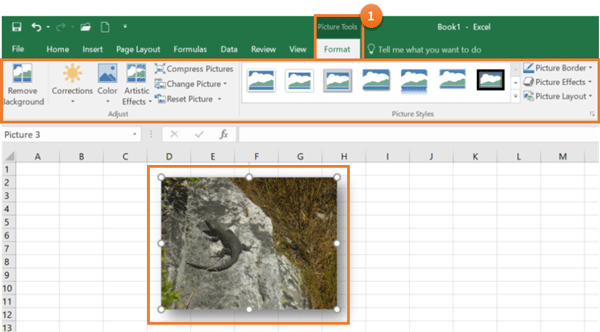
2. When you click away from the picture into a cell, the Picture Tools – Format tab disappears, along with the related options on the Ribbon Command area:
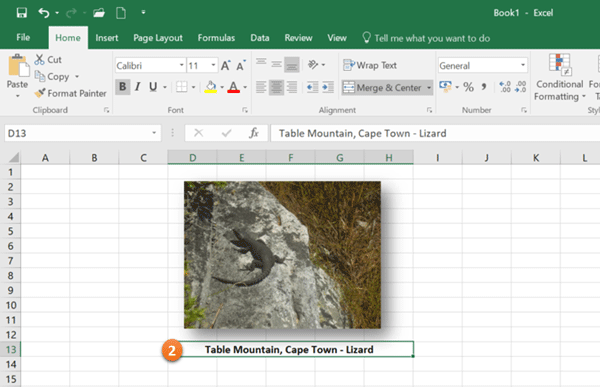
When working with specific content in Excel, such as images, tables, charts, pivot tables, shapes, icons, headers and footers, keep an eye out for contextual tabs that only appear when the object you are working with is selected.
* Quick Access Toolbar Excel 2016 – The shortcut menu or QAT
The Microsoft Office shortcut menu, known as the Quick Access Toolbar and QAT for short, is a miniature version of the Ribbon. It contains shortcut buttons to frequently used functions and is easy to customize.
Study your version of Microsoft Excel 2016, can you locate the Quick Access Toolbar?
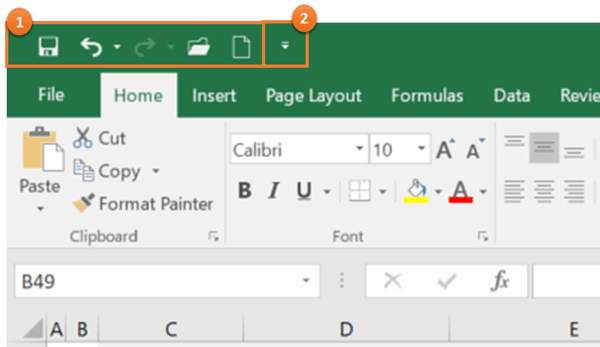
1. The Quick Access Toolbar contains shortcut buttons to functions found on the Ribbon as well as less easily accessible options. The QAT in the screenshot above contains shortcuts to Save, Undo, Redo, Open and New and clicking on any of these icons will execute the function they represent.
2. The Quick Access Toolbar can be modified by clicking on the Customize the Quick Access Toolbar icon to the right of the QAT shortcut icons.
The QAT – Quick Access Toolbar can be displayed both above and below the Ribbon:
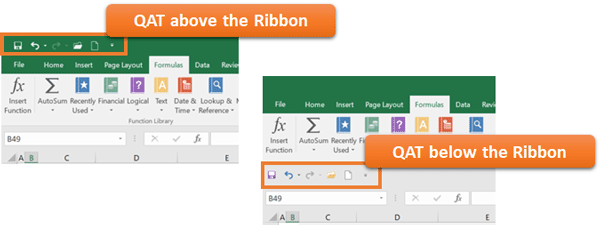
To move the Quick Access Toolbar to above or below the Ribbon, click on the Customize the Quick Access Toolbar button located to the right of the QAT icons, and select either Show Above the Ribbon or Show Below the Ribbon from the menu options.
* Adding buttons to the Quick Access Toolbar Excel 2016
The Excel Quick Access Toolbar or shortcuts menu is easy to modify. If there are any functions you frequently use in Excel, why not add them to the Quick Access Toolbar and save yourself time having to navigate through the Ribbon, Backstage View and Options menus.
To add buttons to the QAT:
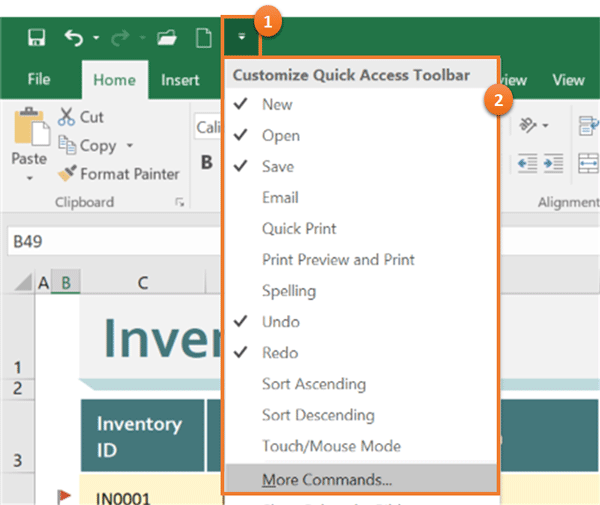
1. Click on the Customize the Quick Access Toolbar button located to the right-hand side of the icons on the toolbar.
2. Select any of the button options listed in the menu by clicking on the option. If the option has a tick mark next to it on this list, it is already on the QAT. Remove it by clicking on the list item to remove the tick. Click on More Commands to access advanced options and settings to add to the Quick Access Toolbar.
TIP: To quickly add shortcuts from the Ribbon to the Quick Access Toolbar, find them on the Ribbon, right-click and select Add to Quick Access Toolbar.
Woohoo! Now that you have done the tutorial:
Test your Excel skills with the corresponding FREE Online Multiple Choice
The Excel Ribbon & Quick Access Toolbar Test – 2016 Excel Basics Test
* TRY THE NEXT TEST: Window and Zoom Options in Excel 2016
* TRY THE NEXT TUTORIAL: Window and Zoom Options in Excel 2016



